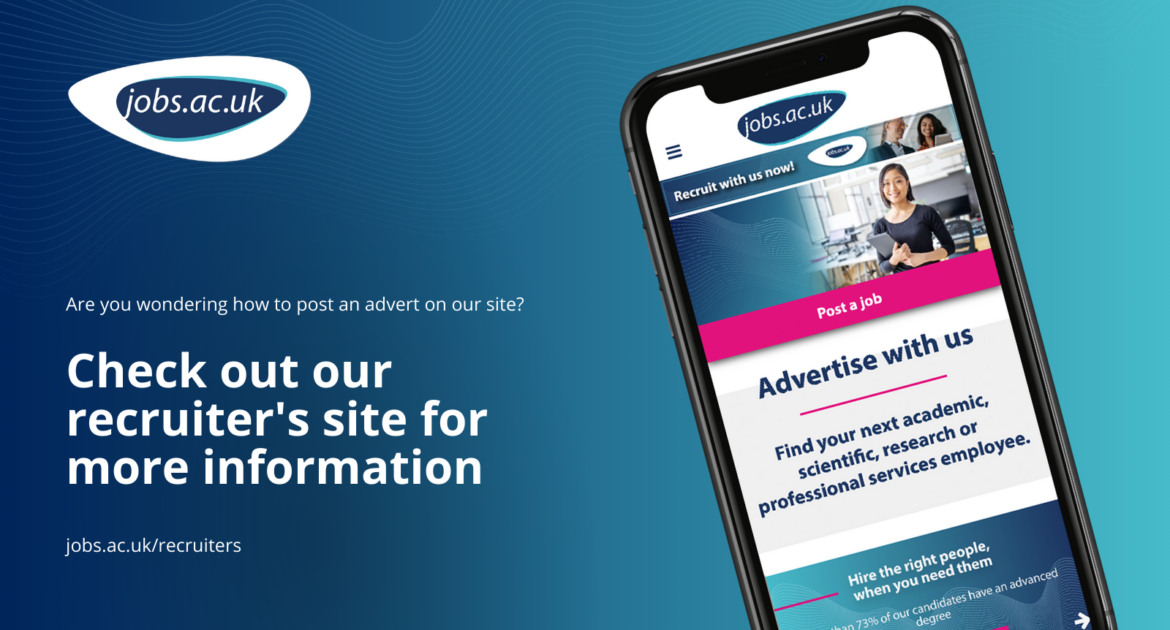As one of the industry’s longest-established jobs boards, jobs.ac.uk has helped thousands of employers worldwide to recruit the brightest talent in the Higher Education (HE) sector for over 25 years.
But how can you guarantee you’re reaching the right audience? How can you engage the best talent on jobs boards? How can you ensure you get the best response to your job advert every time?
To help, we’ve put together some handy tips and techniques to improve the success of your online recruitment advertising.
Choosing the right job board
Job boards are an essential tool for online recruitment, therefore, choosing the right jobs board for your vacancy is crucial to the success of your online recruitment campaign.
jobs.ac.uk is an international job board for the higher education sector, which has many benefits:
- Attract jobseekers with a specific skill set or background
- More relevant, targeted applications
- Reduced competition from other employers
- Industry-specific resources such as salary checkers, blogs, and career information – helping to attract passive jobseekers
- Our account management team will have a more in-depth understanding of your sector and the candidates you are looking to attract
Advertising with jobs.ac.uk provides you with the opportunity to reach a global audience of jobseekers, with over 3.5 million jobseekers from the UK and over 2.4 million across Europe, Asia, Africa, the Americas and Australasia1. You are also in good company as 82% of the world’s top universities advertise with us 2.
jobs.ac.uk also attracts millions of users, with 153 million user interactions and 29 million page views from August 2022 to July 2023 3 with a variety of methods such as events, marketing campaigns, search marketing, social media advertising and utilising our over 25-years’ experience in the field.
Benefits of Online Recruitment Advertising
- Cost
Compared to traditional print advertising, online recruitment is cost effective. jobs.ac.uk also offer a variety of support and tools such as campaigns and employer profiles to support your recruitment goal.
- Wide audience
Online advertising can reach a significant audience as the internet is not limited by geography. Finding the right candidate has never been easier with the wide use of smartphones and tablets, potential employees can discover your jobs at the touch of a button.
- Speed
When you advertise with jobs.ac.uk, you will have a dedicated Account Manager and Account Coordinator who will support all aspects of your recruitment advertising, ready to get your advert out there and receiving applicants in no time. With an aim of having your advert placed in two days, and the option of rapid placement for same day publishing.
- Measurability
Online adverts come with a variety of measurable metrics, from page views to apply clicks so you can see how many people the advert is reaching. Social media engagement is another aspect that can be quantified.
- Ease of use
Posting a job on jobs.ac.uk is straightforward. Your account management team will guide you through the process, answering questions and giving advice. Once you are familiar there is the option to self-submit, advertising has never been easier.
Advert checklist
Here is a quick checklist to make sure your advert is on the right track
Do include:
- Descriptive job title
- Short organisation introduction
- Be clear, be concise
- Job role
- Job requirements – the ideal candidate
- Salary and benefits
- Clear and simple call to action
Don’t include:
- Too much technical detail and jargon
- Unnecessary words
- Unappealing description of the role
- Too much emphasis on the job and not enough on the ideal candidate
Maximise your campaign
With often thousands of jobs live on a jobs board at any one time, making your job advert stand out and helping to emphasise your organisation’s brand is important. In addition to standard job adverts, jobs.ac.uk offer a vast array of enhanced features to ensure your recruitment campaign is as successful as possible.
- Enhanced adverts
We offer, in addition to our standard advert, a standard advert + and enhanced advert which can include employer branding, highlighting in the search results, video content and more.
- Homepage banners and buttons
On the jobs.ac.uk homepage, we have Featured Buttons, Spotlight Buttons, and a Premier Banner. These are used to prominently highlight a specific job vacancy to help channel more jobseekers to your job advert. They can also be used to promote your employer brand and direct jobseekers to your employer profile or linking page where you can link all your adverts on our site on one page.
- Targeted features
To target a specific audience, we have three options: Featured Job by Email, Targeted Email, and a Targeted Button. Each option directs your job to a relevant audience of active jobseekers looking for the opportunity to work in your field.
- Packages
We offer multiple packages, fit for purpose, for those hard to fill or senior roles that need more attention, combining enhanced features we know are proven to work great together, saving you the work of deciding which features will achieve your goal.
1 GA4 Geographical breakdown of website users 1 Aug 2022 – 31 July 2023
2 QS World University Rankings
3 GA4 data (12-month estimate based on 1 Aug 2022 – 31st July 2023)


Share your comments and feedback